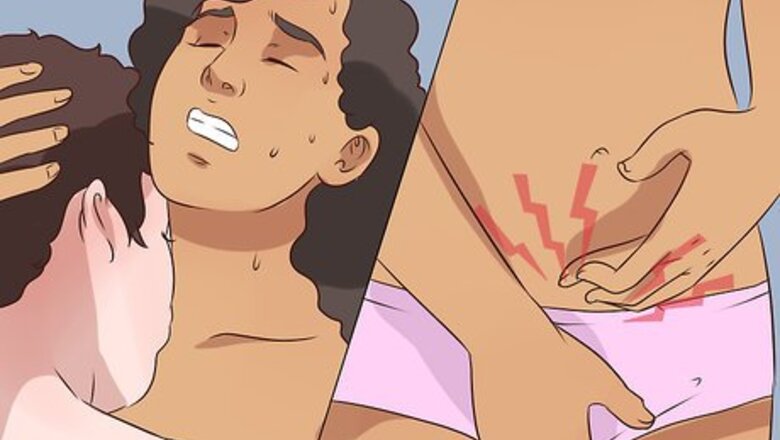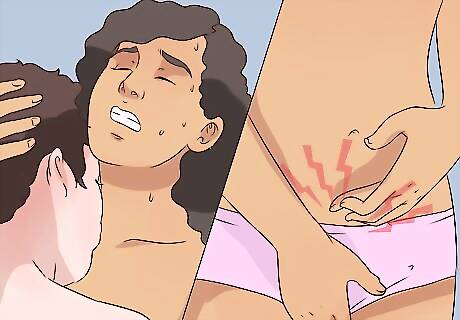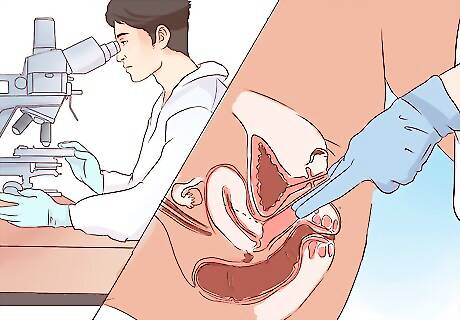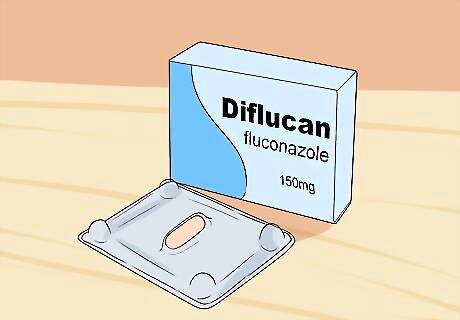
views
X
Research source
Assessing the Symptoms

Check for symptoms. There are a number of physical signs that may indicate a yeast infection. The most common symptoms include: Itching (particularly on the vulva or around the opening of the vagina). Soreness, redness, and overall discomfort in the vaginal area. Pain or burning during urination or sex. Thick (like cottage cheese), white, odorless discharge in the vagina. Note that not all women experience this symptom.

Consider the potential causes. If you are having trouble telling whether or not you have a yeast infection, then consider some of the most frequent causes of yeast infections: Antibiotics - Many women develop a yeast infection after taking antibiotics for several days. Antibiotics kill some of the good bacteria in your body, including the bacteria that prevents the overgrowth of yeast, which can cause yeast infections. If you have been taking antibiotics recently and are experiencing vaginal burning and itching, you might have a yeast infection. Menstruation - A woman is most likely to develop a yeast infection around the time of her period. During menstruation, estrogen deposits glycogen (a type of sugar present inside cells) in the lining of the vagina. When progesterone surges, the cells shed in the vagina making sugar available for the yeast to multiply and grow. So if you're experiencing the above symptoms and it is near the time of your period, then you may have a yeast infection. Birth control - Some birth control pills and one-time "morning after" pills cause a change in hormone levels (mainly estrogen), which in turn can bring about a yeast infection. Douching - Douches are mostly used to clean the vagina after a period. According to the American College of Obstetricians and Gynecologists, douching when done regularly can change the balance of the vaginal flora and the acidity of the vagina, thus disturbing the balance of good and bad bacteria. The level of bacteria helps maintain the acidic environment and its destruction can cause the overgrowth of the bad bacteria, which in turn causes yeast infections. Existing medical conditions - Some diseases or conditions, such as HIV or diabetes, can also cause yeast infections. General health - Illness, obesity, poor sleeping habits, and stress can increase the likelihood of developing a yeast infection.

Take a pH test at home. There is a test that you can take to try to figure out whether you may have a yeast infection. Normal vaginal pH is around 4, which is slightly acidic. Follow any instructions accompanying the test. In a pH test, you hold a piece of pH paper against the wall of your vagina for a few seconds. Then, compare the color of the paper to the chart provided with the test. The number on the chart for the color that best approximates the color of the paper is your vaginal pH number. If the test result is above 4, it's best to see your doctor. This is not indicative of a yeast infection, but could be a sign of another infection. If the test result is below 4, it is likely (but not definitively) a yeast infection.
Getting Diagnosed

Make an appointment with your doctor. If you have never had a yeast infection before or are unsure about the diagnosis, then you should schedule an appointment with your doctor or a nurse at your gynecologist's office. This is the only way to know for sure if you have a yeast infection. It's important to get the diagnosis confirmed since there are different types of vaginal infections that are often misdiagnosed by women as yeast infections. Indeed, although yeast infections are very common among women, they can be difficult to accurately self-diagnose. Research has shown that only 35% of women with a history of yeast infection were able to correctly diagnose a yeast infection from their symptoms alone. If you are currently menstruating, consider waiting until after your cycle finishes to see your doctor, if at all possible. But if you are experiencing severe symptoms, then be seen as soon as possible, even if menstruating. If you are visiting a walk-in clinic and not your regular doctor, be prepared to give a full medical history. Pregnant women should not treat a yeast infection before consulting a doctor.

Undergo a physical examination, including a vaginal exam. To confirm the diagnosis, your doctor will examine the labia and vulva for inflammation, usually without having to do a full pelvic exam. He will then then use a cotton swab to take a sample of vaginal discharge in order to view it under the microscope and look for yeast or other infections. This is called a wet mount and the primary method of confirming a vaginal yeast infection. Your doctor may order additional tests to rule out other causes of your symptoms, such as tests for Sexually Transmitted Infections (STIs). Yeast can be identified under a microscope because it takes a budding or branching form. Not all yeast infections are caused by candida albicans; there are some other forms of yeast as well. Sometimes a yeast culture needs to be performed if a patient continues to get recurrent infections Remember that there are other potential reasons why you may be experiencing vaginal discomfort, including other infections such as bacterial vaginosis or trichomoniasis. For example, many of the symptoms of a yeast infection are very similar to those of an STI.

Get treatment. Your doctor might prescribe you a single-dose tablet of the antifungal medication fluconazole (Diflucan), which is taken orally. Relief can be expected within the first 12 to 24 hours. This is the fastest and most effective cure for a yeast infection. There are also a number of topical treatments available over-the-counter and with a prescriptions, including anti-fungal creams, ointments, and suppositories that are applied and/or inserted into the vaginal area. Talk to your doctor about what might be the best treatment option for you. Once you've experienced a vaginal yeast infection and had it diagnosed by a physician, you can self-diagnose such infections in the future and cure them with readily available over-the-counter treatments. However, even patients who have had yeast infections in the past often misdiagnose themselves. If an over the counter treatment is not working, see your doctor. Call your physician if your symptoms don’t improve after three days or any of the symptoms change (e.g., vaginal discharge increases or changes color).


















Comments
0 comment